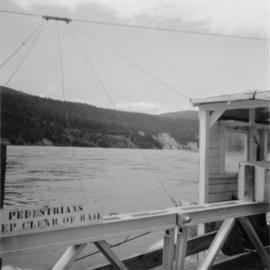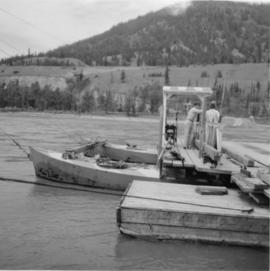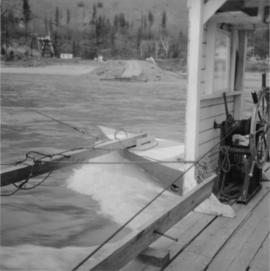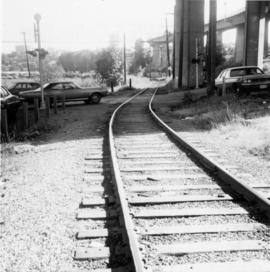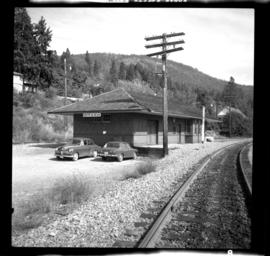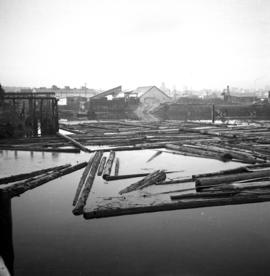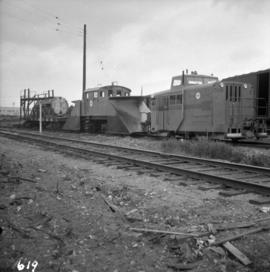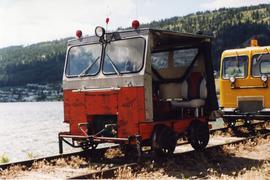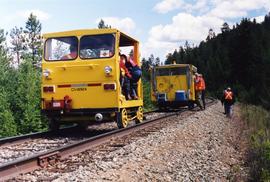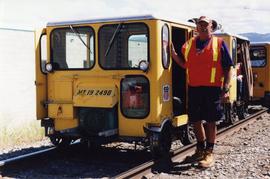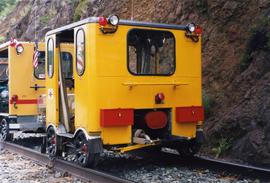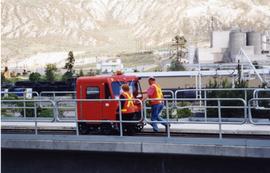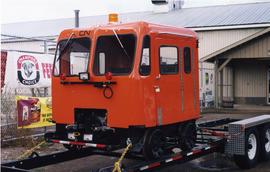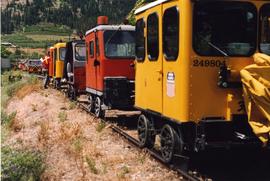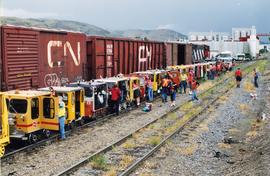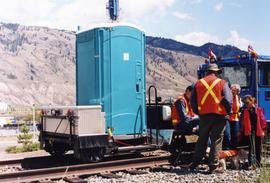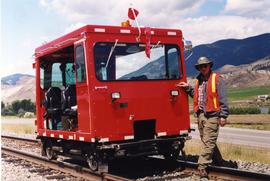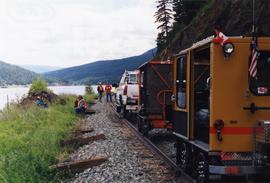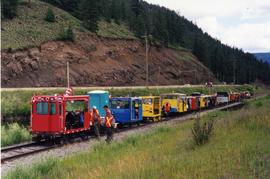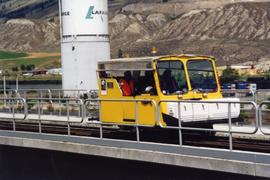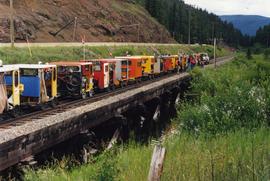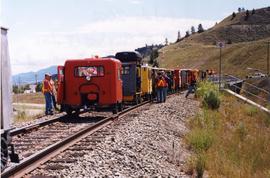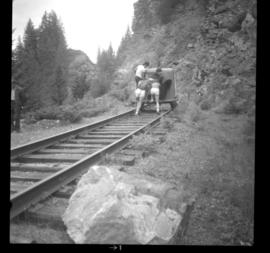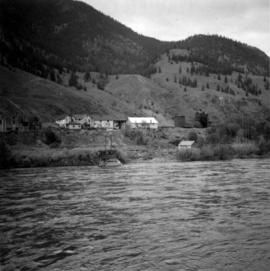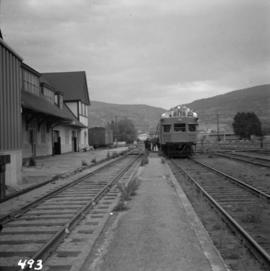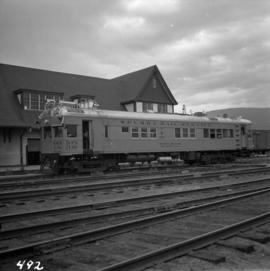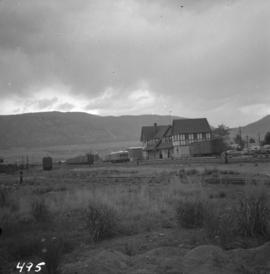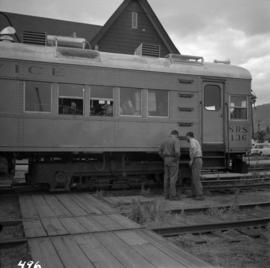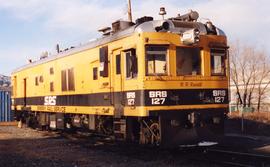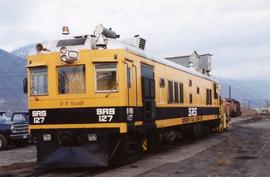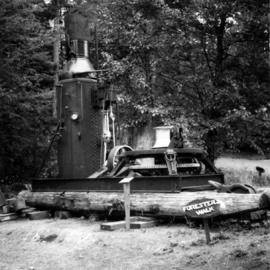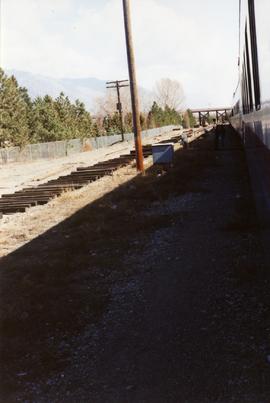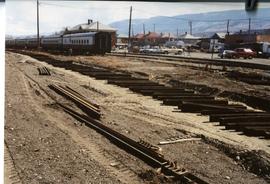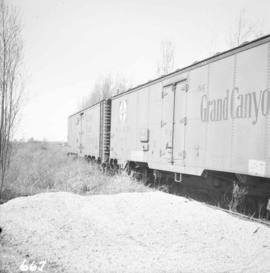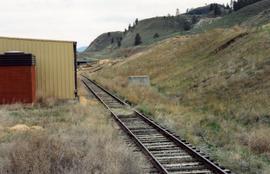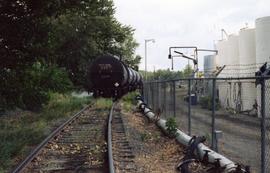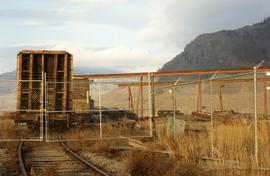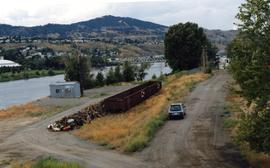Photograph depicts the Soda Creek reaction ferry.
Photograph depicts the Soda Creek reaction ferry.
Photograph depicts the Soda Creek reaction ferry. A ferry was sited between Soda Creek and Marguerite. The reaction ferry in Soda Creek itself had been abandoned for some time.
Subseries consists of sources for railway history research. Includes bibliographies, glossaries, research guides, and indexes.
File consists of general references for railway topics, which predominantly consist of photocopy reproductions and clippings from periodicals. Includes the following articles: "Come Ride the Train: The Story of the National Railway Historical Society" by Cooper; "Sources of Railway Information in the Public Archives of Canada" by Thompson; "Researching Railway History in the Greater Vancouver Area" by Meyer; "B.C. Rail Guide No. 1: Historical Summary of Railways in British Columbia" (1992) by Davies and Nicklason; "Postcards and Railways: How they complimented each other in British Columbia" by Davies; "The Centennial of the Railway and Marine World" by Angus; Also includes the bibliography of David Davies, correspondence with museums and archives, the December 1990 "NMRA Periodical Index", and book reviews of railway monographs.
Map depicts south eastern British Columbia, with highlighted annotations by Davies to emphasize location of rail lines.
Photograph depicts the south shore line of the B.C. Electric Railway in False Creek, Vancouver. B.C. Hydro operated it, if not owned it. The location was directly opposite from Granville Island.
Photograph depicts the South Slocan Junction at mile 11.9 on the CPR line on the Nelson Boundary Subdivision. It closed as an agency in June 1969 but the telegrapher still maintained it. Three to four freights pass per day on the main line: 2 to Trail, 1 to Castlegar pulp mill, and 1 every other day to Midway. On the branch there is 1 train per week to Nakusp that leaves Nelson on Monday, arrives in Nakusp on Tuesday, and returns to Nelson on Wednesday. The view is looking east.
Photograph taken at the east end of False Creek, looking south towarsd Quebec and Ontario Streets.
File consists of research material regarding the Southern Railway of British Columbia (1 Oct. 1988 to present), which was preceded by the BC Hydro Railway (31 Mar. 1962) and the BC Electric Railway Fraser Valley Interurban (4 Oct. 1910). Predominantly consists of photocopy reproductions, excerpts from books, and clippings from periodicals.
Photograph depicts special equipment opposite a car barn of the B.C. Electric Railway, at New Westminster.
Photograph depicts a speeder labelled "Rio Grande."
Photograph depicts a CN speeder.
Photograph depicts a speeder labelled "Union Pacific."
Photograph depicts a speeder at a B.C. speeder meet.
Photograph depicts a speeder car.
Photograph depicts a CN speeder.
Photograph depicts a lunch stop at Oyama for the speeder meet. These speeders were Fairmont MT 19.
File consists of documentary photographs taken by David Davies of a speeder meet between Armstrong and Campbell Creek Junction in British Columbia.
File consists of documentary photographs taken by David Davies of a speeder meet from Vernon to Lumby and Kelowna, British Columbia.
Photograph depicts a speeder meet of "Motor Car Operators West" enthusiasts. Comprised of 25 cars. All taking part in a weekend tour of the Okanagan. On this day, they were going from Vernon to Lumby and Kelowna. Cars were getting ready to depart at the yard of the Kelowna Pacific Railway in Vernon. The cars were headed south to be preceeded by hi-rail of the KPR.
Photograph taken on the outskirts of Kelowna, in an industrial area about 2 miles north of a branch terminal. The turn around point for all 25 speeders was done on a black-topped, little used public grade crossing.
Photograph depicts a speeder meet along the Okanagan line. As trips started and finished in places that had no washrooms, this mobile porto-potty came along and met definite needs.
Photograph taken at a speeder meet. Davies had ridden in this deluxe vehicle for the whole way along the Okanagan line. Margaret Hope, an organizer of the B.C. segment of a three week tour, mentioned that her husband designed and built the machine.
Photograph depicts a speeder meet. People were taking a rest break at the north end of Monte Lake.
Photograph depicts a speeder meet while on a B.C. run from Armstrong to Campbell Creek Junction and back again. About 25 cars were at the south end of Monte Lake.
Photograph depicts a speeder meet at the Campbell Creek Junction. Visible is a large home-built version.
Photograph depicts a speeder meet while on a B.C. run from Armstrong to Campbell Creek Junction and back again.
Photograph depicts a speeder meet of about 25 vehicles. They were leaving the overpass at Campbell Creek Junction for return back to Armstrong.
Photograph depicts a speeder meet at the Campbell Creek Junction. All speeders, consisting of 25, had just turned around and were ready to go south to Armstrong.
Photograph depicts a speeder at the edge of the East Fork Canyon Bridge over Klo Creek. This is located at mile 86.5 on the CPR Kettle Valley Railway in Myra Canyon. The view is looking north.
Postcard depicts a "few miles up river from Spences Bridge this spectacular sight of the deep-blue Thomspon, among the sagegreen hills. Scores of ardent fishermen have found this river excellent for catching Steelhead throughout the fish run." Eastbound way freight of the CPR, upgrade. Way freights going from Kamloops to Ashcroft, etc. Still carried cabooses in 1996. Main line freights lost their cabooses in Jan./Feb. 1990. Photo likely taken in the late 1980s.
Photograph depicts Spences Bridge on the Thompson River and the only surviving pier of the earlier Spences' Bridge. View looking at east bank.
Photograph depicts a Sperry Rail service car #136 at the Penticton C.P.R. depot. It is for detecting faulty or broken rails and visits the area once a year. It is moving off to start work at mile 34 west of Penticton.
Photograph depicts a Sperry Rail service car #136 at the Penticton C.P.R. depot. Note the larger bogie on the right hand bogie which accommodates detection gear. It is being serviced before moving to an area west of Penticton.
Photograph depicts the Sperry Rail service car at the C.P.R. Penticton depot, just moving off to the west.
Photograph depicts the Sperry Rail service car #136 for detection of faulty rails at the Penticton C.P.R. depot. It is used mainly to cover rail manufactured prior to 1932.
Photograph depicts a Sperry Rail Service inspection car that had broken down in the CPR Kamloops yard. Car #127 was built in 1927 as a gas electric car for Boston and Maine R.R. It was modernized in 1989.
Photograph depicts a Sperry Rail testing car in the CPR yard in downtown Kamloops. These cars must have been between 60 and 70 years old, but they were kept in excellent condition. Car #127 was built in 1926 and modernized in 1989.
Postcard depicts one of the spiral tunnels that was constructed in 1909. Built by 1000 men who worked for 2 years to complete it.
Postcard depicts a spiral tunnel near Field, in which trains make a complete turn around the Canadian Rockies. One of two spiral tunnels, and the first of this system introduced on the continent. The greatest pieced of tunnelling ever attempted in Canada. Cost 1,5000,000. Time of work: 20 months. 75 car-loads of dynamite used.
Postcard depicts spiral tunnels.
Photograph depicts an early spool donkey at the Cowichan Valley Forest Museum
Photograph depicts the laying of an extra spur for passenger car storage of Rocky Mountaineer Rail Tours at the CN Downtown Depot in Kamloops.
Photograph depicts the laying of an extra spur for passenger car storage of Rocky Mountaineer Rail Tours at the CN Downtown Depot in Kamloops.
Photograph depicts a spur leading off the Canadian National Railway (CN) spur to the Lafarge Cement Plant on the south bank and east side of Lulu Island. This spur used to be the original line and led to a peat plant, just seen at left on the horizon. The second car is pushed onto unused and overgrown track, which is dated 1909 Algoma Steel. This siding much used.
The building of this spur in 1977 was a late and short lived attempt to move yearling cattle to Ontario for fattening by rail. The Last stock train ran in 1985. The CN rail track was still in use in August 1998. This photograph shows the spur running east and down grade to a stockyard owned by BC Interior Cattlemen's Association. Additional information is available in article, "Moving Livestock by Rail: An inquiry into an extinct traffic" in The Sandhouse journal, Issue 121, Spring 2006.
Photograph depicts a spur located next to Pounder Emulsions Ltd. Electric capstan (Jeffrey Electric Co, Montreal) used to move full and empty tank cars of bitumen (for blacktops). Did not appear to be used.
Photograph depicts Wilkinson Steel Ltd. The spur was serviced by CN. Visible is an empty bulkhead car that had recently been brought in for its steel.
Photograph depicts a spur that terminated close to Red Bridge on the north side of Thompson River. This end section of 200 yards had not been in use for at least 15 years. For 2-3 months near the date the photograph was taken, it was used to load scrap metal.
